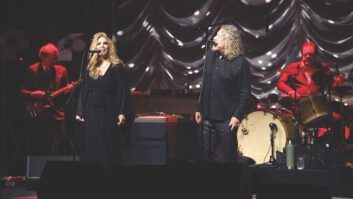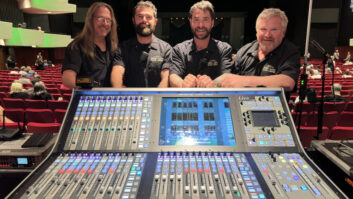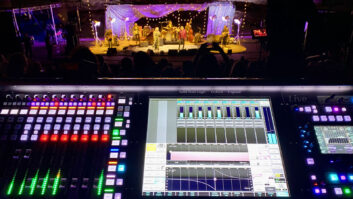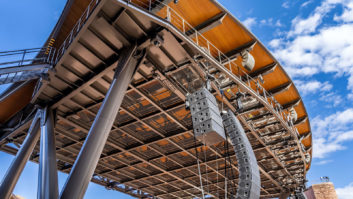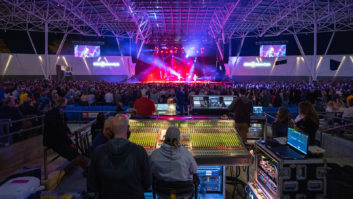Milwaukee, WI (July 25, 2019)—For years, plenty of performances during Milwaukee’s Summerfest have figuratively raised the roof at the 23,500-seat American Family Insurance Amphitheater in Maier Festival Park. But this year, when fans filed into the venue to see Summerfest headliners like Thomas Rhett, Jason Aldean, Bon Iver, Zac Brown Band, Lionel Richie, The Killers and Jennifer Lopez, they discovered that the roof had literally been raised—from 39 feet to 65 feet.
“The main reason we remodeled the amphitheater was that while the old one was state of the art when we built it 20-some years ago, we needed a building that could handle some of the new touring productions,” explains Bob Babisch, vice president of entertainment at Summerfest. The decision to increase clearance above the stage came a few years ago after organizers booked a show they were especially excited to present, only to discover during a conversation between the respective teams that the production wouldn’t have enough clearance at the existing roof height.
The ongoing $53 million, two-year, two-phase project included renovations and improvements to production facilities for this year’s Summerfest, which featured more than 800 artists performing on 12 stages from June 26 through July 7. Improvements include a new adjustable and removable stage, 19 well-appointed dressing rooms, a tripling of production crew catering facilities and construction of new loading docks that can handle nine trucks at once. Phase two, set for completion and a grand opening at Summerfest 2020, encompasses extensive upgrades to audience amenities.
Eppstein Uhen Architects (EUA) designed the amphitheater in 1985; the structure was completed by Hunzinger Construction in 1987. Both companies are overseeing the current renovations. About half the roof—a section measuring 24,100 square feet (half an acre) and weighing 607,000 pounds, extending 125 feet out from the downstage edge—was raised 26 feet in a single day. That task was followed by four months of construction of the supporting structures.
Having identified the need to raise the roof, says Jason Stuewe, architectural designer at Summerfest, “We made sure that we focused on the acoustics and the quality of the sound in the venue, because we knew that this was one of the better-sounding venues in the country; we get a lot of great, positive feedback from touring acts and sound engineers. The number-one priority of this development was to make sure that we did not negatively affect the acoustics.”
In the new layout, the location of the stage in relation to the seating has been changed, he adds, and the P.A. fly points have been moved 20 feet from their previous location.
Over the remaining 5,000 or so seats at the rear of the venue, Stuewe continues, “We left the roof at its existing height to make sure that we could maintain weather protection, allow for additional ventilation and acoustical treatment, and allow the opportunity for some of the energy to leave the building and not bounce around in that space.”
Summerfest brought in Sam Berkow, founder and lead designer of SIA Acoustics—A Division of Robert Derector Associates, to create an acoustical design for the new, larger space that would equal or better the performance of the original venue. “Two things happen when you raise the roof,” says Berkow. “You increase the cubic volume, so reverberation goes up, and you create longer reflections.” Sound now has about twice the distance to travel to reflect off the ceiling, he points out. “It’s about 60 milliseconds farther than it was two years ago.”

Working with the Summerfest team, EUA, Richard Lenz of RealAcoustix, and longtime Summerfest production provider Clearwing Audio, Berkow developed an acoustical design to address both the increase in reverberation and potentially sound-degrading longer reflections. After an initial analysis of the venue before the roof was raised and the development of simulations of the larger space to study the effect of the new reflective structures and increased cubic volume, Berkow also used 3D acoustic simulations that Clearwing created using L-Acoustics’ Soundvision software. Based on the data analysis, Berkow advised adding low-frequency absorption on the walls around the stage, plus mid-frequency diffusor and mid/low-frequency absorption panels safely and securely positioned in the steel roof supports.
Lenz and RealAcoustix make a bass trap product, the BassMod 4848 panel, that Berkow has used in his recording studio designs. “They can be tuned at different frequencies, centered on 70, 63 or 57 Hz, and you can vary the width—half-octave, three-quarters-octave,” says Berkow. He had Lenz build custom 8-foot-tall weatherized versions to surround the stage area.
Lenz also built custom diffusors for the roof. “We had Clearwing do some simulation plans and sections at frequencies we were concerned about and looked at the dispersion. That’s how we picked where to place the panels,” he adds.
With Phase 1 of the project completed, Berkow returned for final measurements and analysis at this year’s Summerfest. The acid test, of course, is the response of an audience that expects an impactful audio experience for the price of a ticket, he says. “The goal for the modern amplified music performance space is to create an environment that’s free from disturbing reflections and provides tonal balance in the reverberance, so you can have impactful bass and articulate vocals that are not strident or difficult to understand,” says Berkow.
“You could clearly see in the two shows that I attended that the audience was hanging on every word. With Billie Eilish, the emotional connection was so great. And it was super fun to hear everyone singing along with Snoop Dogg and Lil Wayne.”
“After Phase 1, we know what the results are in this venue and this space,” says Stuewe. “We’re very happy with the way that the design process and efforts and studies were completed ahead of time.”
“What is so unusual is that these people care,” says Berkow. “I was honored to be a part of their team.” But what impressed him most, he says, was the tremendous pride exhibited by everyone, not just the Summerfest team. “I love when people take pride in their town—and there is lots to be proud of in Milwaukee,” he says.
SIA Acoustics – A Division of Robert Derector Associates • www.siaacoustics.com
